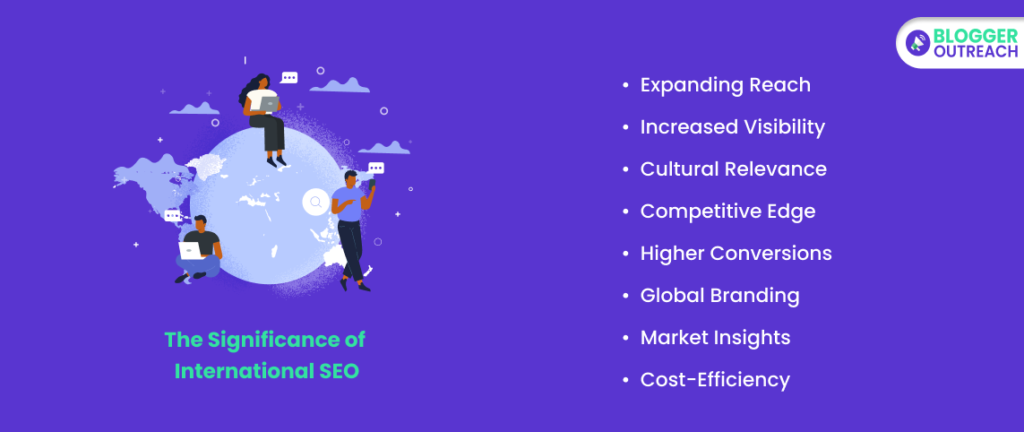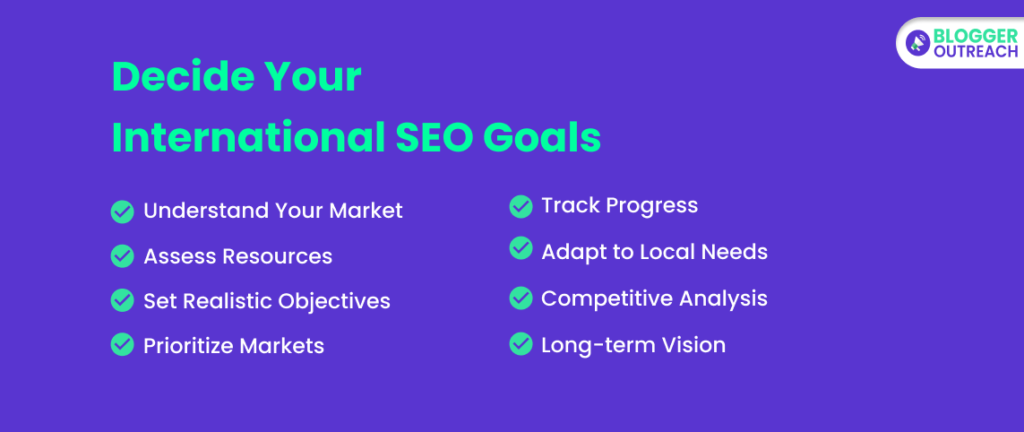Businesses have no boundaries!
Have you always wondered about driving international traffic to your business?
If there’s one thing you need at this moment, without any doubt, it’s international SEO. Guess what?
International SEO will help businesses reach new markets and drive more website traffic. It also helps you rank higher in search engine results and optimize your websites in different countries. In addition, international SEO creates content that is culturally and linguistically appropriate.
This article will help you stay ahead of the curve. You’ll find answers to how, why, and the crucial “what” in the upcoming sections.
So, let’s start.
Table Of Content
What Is International SEO?

International SEO means optimizing your website for specific countries or languages.
In simpler terms, it’s like local SEO but on a global scale.
Imagine you have a company that sells eco-friendly backpacks in the USA, but you want to reach customers in Europe. This is where International SEO comes in.
With the help of international SEO, you can garner organic traffic from various places and languages.
With international SEO, other countries’ search engines can discover your site. It can also indicate the languages you use to target global audiences or native speakers.
The Significance Of International SEO

International SEO opens doors to new markets. It matters for global businesses like yours.
Here’s why:
(i) Expanding Reach
You can reach a wider audience through international SEO. It opens up new markets and makes it easier to reach potential customers.
(ii) Increased Visibility
When you optimize for global search engines, it boosts your online presence. It makes it easier for people worldwide to find your products or services.
(iii) Cultural Relevance
Tailoring content to local cultures and languages builds trust and resonance with international customers.
(iv) Competitive Edge
Staying ahead of competitors in the global arena ensures your business remains competitive and relevant.
(v) Higher Conversions
Targeting international keywords and optimizing user experience can lead to higher conversion rates among global visitors.
(vi) Global Branding
Effective international SEO enhances your brand’s global reputation and credibility.
(vii) Market Insights
International SEO analytics provide valuable insights into consumer behaviour in various markets, aiding strategic decision-making.
(viii) Cost-Efficiency
Focusing on specific international markets can lead to cost-effective advertising and marketing efforts.
How Do You Create A Successful International SEO Strategy?
Following our introduction to international SEO, let’s explore international SEO best practices.
Firstly, it’s crucial to examine your website’s current status:
Check your website’s current organic traffic from different countries and languages. Utilize tools like Google Analytics to analyze visit and conversion trends by country and language.
Evaluate your site’s organic search presence in other nations. Google Webmaster Tools or a dedicated SEO platform can assist in identifying popular queries and pages appearing in search results for the countries you identified earlier.
1. Decide Your International SEO Goals

Setting clear goals gives you guidance and enables you to track your progress. To determine your international SEO goals, consider these steps:
- Understand Your Market: Identify target countries and their online behaviors.
- Assess Resources: Gauge available budget and team capabilities.
- Set Realistic Objectives: Aim for achievable goals like traffic growth or conversions.
- Prioritize Markets: Focus on markets with the most potential and impact.
- Track Progress: Use metrics to measure success and adapt strategies accordingly.
- Adapt To Local Needs: Tailor goals to meet specific cultural and market demands.
- Competitive Analysis: Examine competitors’ strategies and set competitive goals.
- Long-term Vision: Plan for sustained international SEO success.
After you finish implementing the above steps, it’s time to set up your goals.
The Most Common Types Of International SEO Goals Are:
- Increasing Website Traffic: International SEO enhances global visibility, attracting more visitors.
- Generating Leads: Adhering to international SEO best practices attracts qualified leads to your localized site.
- Growing Sales: Effective international SEO educates and organically increases sales over time.
Decide your goal, and then tailor your content accordingly.
2. Choose Between Language And Country Targeting

When reaching global audiences, you’ve got two choices: language or country targeting.
(i) Language Targeting
If your product or service appeals to people regardless of their location, focusing on language targeting can be a smart choice. Here’s how to choose:
For instance, if you offer online language courses, your audience is global, and language targeting makes sense.
Additionally, it is cost-effective as you don’t need to create separate content for each country. One well-optimized piece of content in a common language, such as English, can reach a wide audience.
Let’s say you sell graphic design software. You create content in English because it’s a widely spoken language globally. This allows you to reach graphic designers from various countries without tailoring your content for each location.
(ii) Country Targeting
When your product or service has location-specific aspects or regional differences, country targeting is the way to go.
Country targeting is crucial if your offering varies significantly by location due to legal regulations, cultural preferences, or local market needs.
Imagine you have a chain of fast-food restaurants. In the United States, you might promote hamburgers, while in India, you might emphasize vegetarian options like paneer tikka. Country targeting helps you cater to these local preferences.
3. Understand Your Technical Requirements

We know that you are eager to jump into keyword research. However, analyzing your technical needs for global SEO is important before you do that.
Simply Consider These Steps:
- Dedicated URLs: Each market needs separate content on dedicated URLs for effective targeting. Avoid dynamically translating copies of the same URL.
- URL Structure: Choose between ccTLDs, subfolders, or subdomains. Each has pros and cons. Subfolders are often favoured for simplicity.
- Parameterized URLs: Avoid this option, as it’s not user-friendly and can confuse search engines.
- Content In Multiple Languages: If your target audience speaks multiple languages, provide content accordingly.
- Language vs. Country Targeting: Decide whether to target users by language or specific countries. Google supports both.
- Country-Specific Content: Opt for country-specific content for better localization, addressing currency and terminology differences.
- Content Delivery Network (CDN): Implement a CDN to enhance international users’ site speed and user experience.
4. Research Keywords Separately For Each Market

International SEO is heavily reliant on keywords. Perform separate keyword research to reach diverse markets effectively.
Research helps identify terms and phrases used by each market’s customers. So, create optimized content and pages in the local language based on this research.
In many cases, it’s essential to understand the keywords’ context rather than simply translate them. Some industries, like medicine or IT, often use English terms even in non-English-speaking countries.
Adapt keywords to local search patterns. For instance, the Spanish equivalent of the word “computer” is “ordenador”, which is more likely to be searched than the Spanish translation of “computer”.
Use tools like Google Adwords’ Keyword Planner to find relevant keywords and their search volumes. Incorporate these keywords into your international SEO strategy.
5. Use Hreflang Attribute The Right Way

Hreflang Attribute is a map for search engines to navigate multilingual and multinational websites. As a result, when people search for content, they find the most relevant version in their native language. The process is as follows:
(i) Language And Region Targeting
Language Targeting: If your website offers content in multiple languages, hreflang helps you specify which page corresponds to which language. For example, you can use it to tell search engines that one page is in English (en) and another is in Spanish (es).
Region Targeting: If your content varies by region, hreflang helps you define which page is meant for specific countries or regions. For instance, you can specify that one page is for the United States (en-us) and another for the United Kingdom (en-uk).
(ii) Avoiding Duplicate Content
Without hreflang, search engines might mistakenly see similar pages in different languages or regions as duplicate content. In fact, this can lead to lower search rankings. Using Hreflang tags clears up this confusion, making each page look unique and relevant.
(iii) Improving User Experience
When users search in their preferred language or from a specific region, hreflang helps search engines display the most relevant results. This enhances the user experience, as people are likelier to find content they can understand and relate to.
(iv) Correct Implementation
To use hreflang effectively, you need to place the hreflang tags in the HTML of your web pages. These tags indicate the language and country of each page. Proper implementation is crucial, as mistakes can lead to incorrect indexing and ranking issues.
(v) Example
Let’s say you run an online fashion store with pages in English (en), Spanish (es), and French (fr). You want to target both the United States and Canada.
You Would Use Hreflang Tags Like This:
English page for the United States: <link rel=”alternate” hreflang=”en-us” href=”https://example.com/us/en” />
English page for Canada: <link rel=”alternate” hreflang=”en-ca” href=”https://example.com/ca/en” />
Spanish page for the United States: <link rel=”alternate” hreflang=”es-us” href=”https://example.com/us/es” />
French page for Canada: <link rel=”alternate” hreflang=”fr-ca” href=”https://example.com/ca/fr” />
6. Build Location-Specific Backlinks

Even if you have a strong reputation in your own country, you can’t rely solely on backlinks from authoritative sites there.
Here’s why: A backlink from a highly respected website in your country might not carry the same weight in another new market you’re targeting. Each region has its own online ecosystem, and you need to establish your presence within it.
Surprisingly, many people tend to overlook this step. In new markets, they forget to build a backlink profile as part of their digital strategy. As a result, they end up with traffic that’s directly linked to their lack of localized links.
So, here’s the takeaway:
Backlinks Are All About Relevance
Don’t neglect this crucial step. Ensure you actively build your backlink profile and digital presence within every market you’re targeting. It’s the key to gaining credibility and visibility in those new regions.
7. Create Local Content For International SEO Success

To grab the attention of users in the target market, adapt your writing style and tone to resonate with the local audience.
You should take a user-centric approach here. Focus on addressing your local audience’s specific needs and interests. Create content that solves their problems, answers their questions, or entertains them in a way that resonates with their preferences.
For better results, here you need native writers. However, outsourcing a native writer is costly. This is where a content writing agency comes into the picture. Top agencies have an in-house team specialized in localized content.
Another approach entails skilled language experts adapting your initial content using localization technology. This method offers the benefit of taking charge of the process, allowing for enhanced control and ensuring top-notch quality.
Final Verdict – Essential Parameters To Gauge Your International SEO Performance
Once you have implemented these strategies, assessing your international SEO performance is important by reviewing the following metrics.
- Organic Traffic: Check how many visitors your site attracts from different countries. This shows your global reach.
- Keyword Rankings: Monitor your target keywords’ positions in search results worldwide to gauge visibility.
- Click-Through Rate (CTR): Assess the ratio of clicks to impressions for international keywords. It indicates user interest.
- Bounce Rate: See if users engage with your content or leave quickly. Lower is better.
- Conversion Rate: Track the percentage of visitors who complete desired actions (e.g., purchases, sign-ups).
- Localization Efforts: Evaluate how well your site adapts to local languages, currencies, and cultures.
- Mobile Optimization: Ensure your site is mobile-friendly to cater to diverse devices globally.
- Backlinks: Analyze the quality and quantity of international backlinks. They boost authority.
- Page Load Speed: Faster pages enhance user experience worldwide and impact rankings.
- Global Competitors: Monitor competitors’ international SEO strategies and adapt accordingly.
BloggerOutreach is a one-stop organization for all your digital marketing requirements along with services like SEO, link building, and content writing.
If you have queries, you can contact our experts!
Read More:









